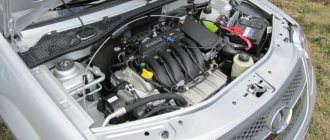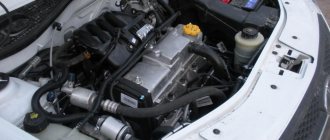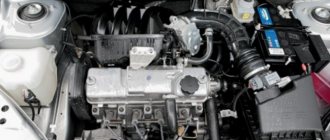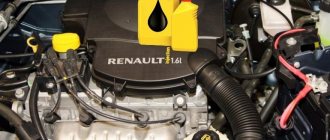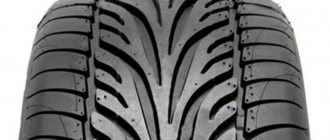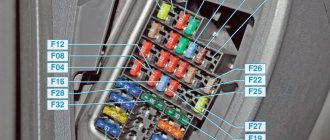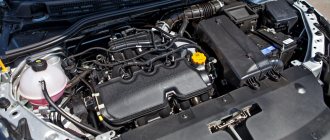Engine 21129 was created specifically for Lada Vesta and X-Ray. The main development requirements were:
- adaptation to the AMT gearbox manufactured by AvtoVAZ and manual automatic transmission from Renault;
- raise environmental standards to Euro 5;
- increase power and service life.
Of all the manufacturer's engines existing at that time, version 21127 partially satisfied these conditions. It bends the valve, but has many advantages that cover this disadvantage, which is why it became the base model for tuning, and the number of modifications became minimal.
Characteristics of motor 21129
On the one hand, the 21127 engine, which served as the base version for the creation of 21129, is in turn a tuned modification of 21126, so most of the components in the engine remained the same to reduce production costs. From another point of view, the manufacturer took into account the disadvantages of upgrading its subsidiary to the ICE 21128, so the final engine diagram looks like this:
- the cylinder diameter and piston stroke remained classic for front-wheel drive engines - 82 mm and 75.6 mm, respectively;
- the gas distribution mechanism of the engines remained unchanged - DOHC with two overhead camshafts;
- the cylinder head, connecting rod-piston group and cylinder block have not undergone any changes;
- the entire intake tract with an integrated receiver, DBP and DTV sensors instead of the mass air flow sensor has been preserved;
- the attachments have been partially changed - new pillows, generator and exhaust manifold;
- The engine cooling system and fuel injection have been improved.
The most important feature of 21129 was the new version of the ECM firmware - M86. As a result, gasoline consumption decreased, torque and power increased to 148 Nm and 106 hp. s., respectively. That is, the modernization did not affect the volume of combustion chambers of 1.6 liters.
A full description of the motor parameters is given in the instructions, and the main technical characteristics of 21129 are contained in this table:
| Manufacturer | AvtoVAZ |
| Engine brand | 21129 |
| Years of production | 2015 – … |
| Volume | 1597 cm3 (1.6 l) |
| Power | 78 kW (106 hp) |
| Torque moment | 148 Nm (at 5800 rpm) |
| Weight | 110 kg |
| Compression ratio | 10,5 |
| Nutrition | injector |
| Motor type | in-line |
| Injection | distributed electronically controlled |
| Ignition | coil for each spark plug |
| Number of cylinders | 4 |
| Location of the first cylinder | TVE |
| Number of valves on each cylinder | 4 |
| Cylinder head material | aluminum alloy |
| Intake manifold | combined with receiver, polymer, built-in damper, DTV and DBP sensors |
| An exhaust manifold | catalyst |
| Camshaft | 2 pcs., marks on pulleys are offset by 2 degrees |
| Cylinder block material | cast iron |
| Cylinder diameter | 82 mm |
| Pistons | lightweight, manufacturer Federal Mogul |
| Crankshaft | from 11183 |
| Piston stroke | 75.6 mm |
| Fuel | AI-95 |
| Environmental standards | Euro 5 |
| Fuel consumption | highway – 5.3 l/100 km combined cycle 6.6 l/100 km city – 9 l/100 km |
| Oil consumption | maximum 0.1 l/1000 km |
| What kind of oil to pour into the engine by viscosity | 5W-30 and 10W-40 |
| Which engine oil is best by manufacturer | Liqui Moly, LukOil, Rosneft, Mannol, Mobil |
| Oil for 21129 according to composition | synthetics, semi-synthetics |
| Engine oil volume | 3.5 l |
| Operating temperature | 95° |
| Motor life | declared 200,000 km actual 300,000 km |
| Adjustment of valves | hydraulic compensators |
| Cooling system | forced, antifreeze |
| Coolant quantity | 7.8 l |
| water pump | with metal impeller |
| Candles for 21129 | BCPR6ES from NGK or domestic AU17DVRM |
| Gap between spark plug electrodes | 1.1 mm |
| Timing belt | Gates, width 22 mm, service life 200,000 km |
| Cylinder operating order | 1-3-4-2 |
| Air filter | Nitto, Knecht, Fram, WIX, Hengst |
| Oil filter | catalog number 90915-10001 replacement 90915-10003, with check valve |
| Flywheel | increased damper size |
| Flywheel mounting bolts | box MT – M10x1.25 mm, length 26 mm, groove 11 mm box AT – M10x1.25 mm, length 26 mm without groove |
| Valve stem seals | code 90913-02090 inlet light code 90913-02088 exhaust dark |
| Compression | from 13 bar, difference in adjacent cylinders maximum 1 bar |
| XX speed | 800 – 850 min-1 |
| Tightening force of threaded connections | spark plug – 31 – 39 Nm flywheel – 62 – 87 Nm clutch bolt – 19 – 30 Nm bearing cap – 68 – 84 Nm (main) and 43 – 53 (rod) cylinder head – three stages 20 Nm, 69 – 85 Nm + 90° + 90° |
The developers recommended equipping the 21129 engine with the plant’s cars with the GFL12 robotic gearbox, the VAZ GFL11 manual gearbox and the Renault GFL13 manual gearbox.
Technical characteristics of Lada Largus engines
Engine model
| RENAULT, K4M | RENAULT, K7M | |
| Injection type | Electronically controlled multipoint fuel injection | |
| Fuel type | Gasoline Premium-95 GOST 51105-97 | |
| Number and arrangement of cylinders | 4, in-line | |
| Number of valves | 16 | 8 |
| Cylinder operating order | 1-3-4-2 | |
| Direction of rotation of the crankshaft (camshaft drive side) | ||
| right | ||
| Cylinder diameter/piston stroke, mm | 79,5×80,5 | |
| Working volume, cm 3 | 1598 | |
| Compression ratio | 9,8 | 9,5 |
| Toxicity standards | Euro 4 | |
| Power at 5500 rpm, kW (hp) | — | 62 (84) |
| Power at 5750 rpm, kW (hp) | 77 (105) | — |
| Maximum torque, N.m (at rpm) | 148 (3750) | 124 (3000) |
| Volume of oil poured into the engine lubrication system, including oil filter, l | 4,8 | 3,3 |
Design Features
Initially, engine 21129 retained the design of the basic version 21127:
- “tall” gray cylinder block, transferred from 11183, the surfaces of the liners are processed by honing;
- Cylinder head from modification 21124;
- gas distribution mechanism with phased injection with hydraulic compensation of thermal valve clearance;
- lightweight piston group from Federal Mogul;
- V-belt drive of timing camshafts with rounded teeth from Gates with a service life of 200,000 km;
- crankshaft with long radius crank from internal combustion engine 11183;
- fuel rail with medium-performance injectors from Bosch or Siemens;
- individual spark plug ignition coils without a high-voltage wire bundle;
- increased diameter of the damper on the flywheel;
- catalytic converter built into the exhaust tract - catalytic collector.
Thus, the manufacturer does not provide for boosting the internal combustion engine in principle. Power and torque remained the same, oil consumption within 100 g/1000 km. The manual created by AvtoVAZ designers contains step-by-step operations, thanks to which major repairs can be done with your own hands.
Advantages and disadvantages
The advantages of the 21129 engine are:
- economical consumption of coolant, engine oil and fuel;
- compliance with Euro-5 standards;
- improved attachments;
- overhaul on your own;
- declared resource 200,000 km;
- absence of periodic adjustments of valve thermal clearances.
To ensure the specified motor life, the manual recommends using only high-quality lubricants from reliable manufacturers. The disadvantages of the power drive design are:
- expensive maintenance due to the need for high-quality oil in hydraulic pushers;
- high capital repair budget due to the use of ShPG and timing belt kits from foreign companies;
- there is a danger of bending the valves if the timing belt drive breaks.
The compression ratio has decreased by 0.5 units, which seems to reduce the octane number of the fuel. In practice, the quality of domestic gasoline is unsatisfactory; experts do not recommend experimenting for dubious savings in the operating budget.
What cars was it used in?
Initially, the engine characteristics are higher than those of previous versions, so the 21129 engine is installed on modern AvtoVAZ models:
- Lada Vesta – five-door station wagon, four-door sedan;
- Lada X-Ray – five-door hatchback;
- Lada Largus is a compact cargo van, a five-door station wagon.
The compact and intuitive design of the internal combustion engine does not cause problems during maintenance and overhauls.
Close-up view - K4M engine on video
Depending on the year of manufacture, the Largus may be equipped with a Renault or VAZ engine. Currently, only domestic engines are installed on this car. Let's take a closer look at the technical characteristics of Lada Largus engines, as well as the features of their assembly.
- Renault-Nissan K7M
(8 valves) with a volume of 1.6 liters is capable of developing a power of 84 hp. This motor is installed on the “standard” and “norm” configurations. - Renault-Nissan K4M
(16 valves) is slightly more powerful, with 105 hp. or 77 kW. The motor is provided for the “luxury” configuration. - VAZ 11189
(8 valve engine) began to be installed instead of K7M in 2015. - VAZ 21129
(16 valves) began to be installed instead of Renault K4M in October 2017.
Maintenance
Engine 21129 must be serviced in the following order to ensure a service life of at least 200 thousand km:
- after 10–15 thousand kilometers, it is necessary to take care of replacing the engine lubricant and filter;
- every 20 thousand it is necessary to inspect the cathode collector, spark plugs, alternator belt, battery and crankcase ventilation;
- after 40 - 45 thousand, the coolant and elements of the system of the same name, air and fuel filters, and the tank cap become unusable;
- after passing 90 - 100 thousand, you should check the integrity of the timing belt of the drive; if it breaks, the piston will crush the valve rod;
- According to the resource declared by the manufacturer, the belt is replaced after rolling 180 - 200 thousand km.
Bench tests of selected 21129 engines show that the real power at a speed of 5800 min-1 is 5 hp. With. more.
Malfunctions: causes, elimination
Despite the fact that the 16 valve engine 21129 with adjustable air intake flows and hydraulic valve clearance compensators is considered a very reliable power drive, malfunctions still occur:
| Gasoline consumption has increased | 1) catalyst is clogged 2) fuel pump failure 3) the air filter is clogged | 1)cleaning the exhaust system 2) pump replacement 3) cartridge change |
| Glow type ignition (operation after switching off) | 1) overheating 2) carbon deposits on the surfaces of valves and combustion chambers | 1) repair of the cooling system, refilling of coolant 2) flushing of the system |
| Emergency pressure indication | 1) wear of the oil pump or main bearings 2) sensor malfunction 3) circuit closure 4) oil level is insufficient | 1) replacement of consumables 2) installation of a new sensor 3) wiring repair 4) adding oil |
| Reduced cravings | 1) DPKV breakdown 2) clogged filters 3) COURT firmware failure 4) clutch wear 5) timing adjustment failure | 1) replacing the crankshaft position sensor 2) replacing filters 3) flashing 4)replacement of a set or disk 5) phase adjustment, belt replacement |
The 21129 engine rarely violates idling speed conditions due to the redundant adjustment system.
K4M on Lada Largus Cross versus 8 valve
We have already said what engine is in the Lada Largus Cross - it is K4M. Now let’s study what its 8-valve “competitor” looks like. Until 2010, it developed 90 horsepower, and then, during the transition to the new Euro standard, the power decreased. But one graph has remained since then.
Torque chart for K7M
You can remember only two numbers - 105 and 121. This is how many newtons per meter the motor develops, if you look at the ends of the 1000-2000 range.
Now let's look at a similar graph relating to the 16-valve. Here, even at one thousand rpm, the torque is 110 N*m. And two thousand corresponds to the numbers 135.
Torque chart for K4M
It turns out that the 16-valve engine will be more torquey even in the “lower” frequency range (1000-2000). Of course, this looks atypical.
The general rule is this: an 8-valve engine pulls better at the bottom, and a larger number of valves only produces high power. Here, as we see, the rule was broken. But it is broken for the benefit of the buyer.
Details about the 16-valve Cross engine
It is known that the Renault K4M engine exists in several versions. The best of them is 110-horsepower. We are talking about a motor with automatic phase control, invented by Renault many years ago. You can find such a motor under the hood of the Duster crossover.
This is what a timing belt corrector should look like
Almost the same motor, where the phase regulator was replaced with a regular gear, ended up under the hood of the Lada Largus. It develops 102 horsepower, and just like its 110-horsepower brother, it complies with Euro-5 standards.
We look at the engine on the Cross version from the inside
As already mentioned, the Lada Largus Cross engine can only develop 102 “power”. Here a regular gear is put on each of the shafts. Now, if there was a “regulator” on the right, the power would increase to 110.
ICE K4M, Largus family
The “phase regulator” itself is a complex and expensive unit. It is often damaged due to low-quality fuels and lubricants. In general, VAZ designers decided not to take risks, protecting the consumer in advance. No unnecessary details - no problems. Normal logic.
According to the regulations, the “phase regulator” is supposed to be changed every 120,000 km. And the cost of this part exceeds the price of 10 timing belts. Such a “Cross” - who in Russia would need it?
The main “plus” of the K4M engine is its hydraulic compensators. 8-valve engines have nothing like that.
Here's a "hydrik" and a "hydrik"!
The number of compensators is 16, and they make the operation of the motor almost inaudible. Moreover, this is done in any of the modes - even at low speeds under load. But the crossover, in theory, should just “make noise” - there is nothing strange about that. However, preference was given to the 16-valve engine model. Whether this is good or bad, the buyer will decide.
If the timing belt breaks, each of the two engines – both K4M and K7M – will bend its valves. There is parity between them. In other respects, the 8-valve model turns out to be worse. But maybe the reader has a different opinion on this matter. Then share it with us.
Tuning
Thanks to the standard design, the 21129 motor has a potential of 150 hp. The most popular modernization of internal combustion engines is in the following ways:
- tuning of the block and cylinder head - boring the cylinders up to 88 mm maximum, grinding the head channels, installing lightweight pistons;
- tuning of the intake tract – 54 mm damper instead of the standard one, filter with zero air resistance;
- tuning of the exhaust tract - spider at the exit;
- timing modernization - modification of 8.9 Stolnikov camshafts with mandatory phase adjustment.
VAZ engines are turbocharged with rotary compressors, superchargers or mechanical turbines. However, inertial mechanical pressurization is already present inside the standard receiver, so this option is not economically viable.
Thus, the Euro 5 standard has been achieved in the 21129 engine without increasing power and making special design changes to the basic version 21127. The M 86 control unit of the next firmware version is used. The valves are not protected from bending by the pistons, the overall user rating is +4.
If you have any questions, leave them in the comments below the article. We or our visitors will be happy to answer them
Price Lada Largus Cross 2021
- 1.6 l. 16 classes (106 hp), 5MT / Luxe / 5 seats – 689,900 rub.
- 1.6 l. 16 classes (106 hp), 5MT / Luxe / 7 seats – RUB 714,900.
Considering all kinds of promotions, bonuses and discounts, the price may turn out to be even more profitable. Let’s say you can get a 10% discount under the “Family” or “First Car” program.
As for the choice of body color for the Lada Largus in 2018 , the situation is as follows. The basic color is free, for the rest you will have to pay an additional 12 thousand rubles. That is, two-layer white enamel (“Glacial” 221) is free, for the remaining 6 metallic options you will have to pay extra. These are red “Fire Red” (124), gray-beige “Basalt Gray” (242), dark brown “Cashmere” (283), blue “Diplomat” (424), black “Black Pearl” (676) and silver “Platinum” (691).
Below is an approximate image of the color scheme of the Largus station wagon this year. Naturally, such an image cannot convey the fullness of color, especially metallics, but you can get a general idea. The color numbers are shown in the picture below.
Equipment Lada Largus Cross “Lux”
The basic and also the most complete configuration of the Largus Cross is Luxe in a 5- or 7-seater version. Under the hood is the only power unit, the well-known domestic 1.6 liter gasoline engine with 16 valves developing 106 hp. Naturally, the drive is only front-wheel drive, and the gearbox is 5-speed manual. The package includes the following options: • Driver airbag • Front passenger airbag • Rear seat head restraints 3 pcs. • Mountings for ISOFIX child seats • Locking the rear doors against opening by children • Immobilizer • Fog lights • Anti-lock braking system (ABS) • Electronic brake force distribution (EBD) • Protection of the engine and engine compartment • On-board computer • Second row seat with fold-out layout proportions 60/40 • Interior (optional) Orange orange/Gray gray • Leather steering wheel • Passenger sun visor with mirror • 12V socket • Luggage rack on the roof lining • Tensioner luggage rack • Power steering • Height-adjustable steering column • Adjustment front seat height seat belts • Driver's seat with height adjustment and lumbar support • Cabin air filter • Light tinted windows • Central locking with remote control • Power front doors • Power rear doors • Heated front seats • Electric drive and heated exterior mirrors • Sensors rear parking • Air conditioning • Audio system (FM, MP3, AUX, USB, Bluetooth, Hands free), 4 speakers • Exterior mirrors and exterior door handles in body color • Side door moldings • Roof rails • 16-inch alloy wheels with Continental tires • Spare steel wheel for temporary use R15

